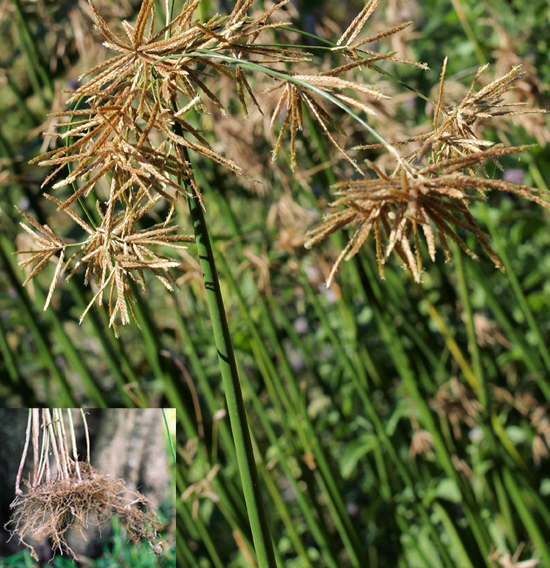Adrue
DESCRIPTION
Medicinal
Parts: Adrue root is used in the West Indies for its anti-emetic
properties.
Flower
and Fruit: The tubers are blackish and ,top-shaped, with bristly
remains of former leaves. The plant is sometimes connected in twos or threes by
narrow underground stems.
The
transverse section is pale, showing a central column with darker vascular
bundles. -
Characteristics:
Adrue
has an aromatic odor and a bitter taste, reminiscent of Lavender.
Habitat:
Turkey,
region of the river Nile, Jamaica.
Production:
Adrue
root is the root of Cyperus articulatus.
The
roots are collected in the autumn, scalded or steamed, and then dried in the
sun.
Other
Names: Guinea Rush
ACTIONS
AND PHARMACOLOGY
COMPOUNDS
Volatile
oil: containing above all sesquiterpene hydrocarbons and
sesqiterpene alcohols, including cyperenone
EFFECTS
Adrue
has anti-emetic, carminative and sedative properties.
INDICATIONS
AND USAGE
Unproven
Uses: Preparations of the root are used for digestive disorders,
nausea and flatulence.
Chinese
Medicine: Used for pre- and post-natal headaches, epigastric pain,
vomiting with bleeding, hematuria, leucorrhea, menstrual irregularities,
tension and pain in the breasts and amenorrhea.
PRECAUTIONS
AND ADVERSE REACTIONS
Health
risks or side effects following the proper administration of designated
therapeutic dosages are not recorded.
DOSAGE
Mode
of Administration: Available as a liquid extract for
internal
use.
Daily
Dosage: 6 to 9 gm of drug
Storage:
Should
be stored in a cool and dry place, protected from insects.
LITERATURE
Bum EN
et al., Extracts from rhizomes of Cyperus articulatus displace 3H CGP39653 and
3H glycine binding from cortical membranes and selectively inhibit NMDA
receptor-mediated neurotransmission. J Ethnopharmacol, 54:103 11, 1996 Nov
Kern
W, List PH, Horhammer L (Hrsg.), Hagers Handbuch der Pharmazeutischen Praxis,
4. AufL, Bde 1-8, Springer Verlag Berlin, Heidelberg, New York, 1969.
Mongelli
E, Desmarchelier C, Coussio J, Ciccia G, Antimicrobial activity and interaction
with DNA of medicinal plants from the Peruvian Amazon region. Rev Argent Microbiol,
27:199-203. 1995 Oct-Dec Pinder AR, (1976) Tetrahedron 23:2172.



0 Comment:
Post a Comment